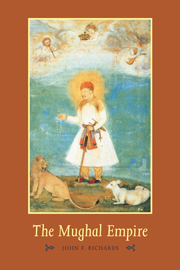Book contents
- Frontmatter
- Contents
- List of maps and tables
- General editor's preface
- Preface
- Introduction
- 1 Conquest and stability
- 2 The new empire
- 3 Autocratic centralism
- 4 Land revenue and rural society
- 5 Jahangir 1605–1627
- 6 Shah Jahan 1628–1658
- 7 The War of Succession
- 8 Imperial expansion under Aurangzeb 1658–1689
- 9 The economy, societal change, and international trade
- 10 Maratha insurgency and Mughal conquest in the Deccan
- 11 The Deccan Wars
- 12 Imperial decline and collapse, 1707–1720
- Conclusion
- Glossary
- Bibliographic essay
- Index
- THE NEW CAMBRIDGE HISTORY OF INDIA
Introduction
Published online by Cambridge University Press: 28 March 2012
- Frontmatter
- Contents
- List of maps and tables
- General editor's preface
- Preface
- Introduction
- 1 Conquest and stability
- 2 The new empire
- 3 Autocratic centralism
- 4 Land revenue and rural society
- 5 Jahangir 1605–1627
- 6 Shah Jahan 1628–1658
- 7 The War of Succession
- 8 Imperial expansion under Aurangzeb 1658–1689
- 9 The economy, societal change, and international trade
- 10 Maratha insurgency and Mughal conquest in the Deccan
- 11 The Deccan Wars
- 12 Imperial decline and collapse, 1707–1720
- Conclusion
- Glossary
- Bibliographic essay
- Index
- THE NEW CAMBRIDGE HISTORY OF INDIA
Summary
The Mughal empire was one of the largest centralized states known in pre-modern world history. By the late 1600s the Mughal emperor held supreme political authority over a population numbering between 100 and 150 millions and lands covering most of the Indian subcontinent (3.2 million square kilometers). Timurid India far outstripped in sheer size and resources its two rival early modern Islamic empires – Safavid Persia and Ottoman Turkey. The Mughal emperor's lands and subjects were comparable only to those ruled by his contemporary, the Ming emperor in early modern China.
The “Great Mughal's” wealth and grandeur was proverbial. His coffers housed the plundered treasure of dozens of conquered dynasties; his regalia and throne displayed some of the most spectacular precious stones ever mounted. Nearly all observers were impressed by the opulence and sophistication of the Mughal empire. The ceremonies, etiquette, music, poetry, and exquisitely executed paintings and objects of the imperial court fused together to create a distinctive aristocratic high culture. Mughal courtly culture retained its appeal and power long after the empire itself had declined to a shell. Today the Mughal style as represented in miniature paintings, or much-admired buildings like the Taj Mahal, has an immediate and powerful attraction.
For nearly one hundred and seventy years (1556–1719) the Mughal empire remained a dynamic, centralized, complex organization. The emperor commanded cadres of officials and soldiers of proven loyalty who carried out his orders in every province. Men, money, information, and resources moved regularly and routinely throughout the empire as official needs dictated. Mughal success was the product of hard-driving, active rulership exercised by extremely capable rulers who acted as their own chief executives.
- Type
- Chapter
- Information
- The Mughal Empire , pp. 1 - 5Publisher: Cambridge University PressPrint publication year: 1993

